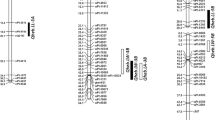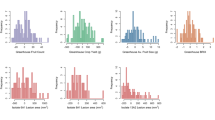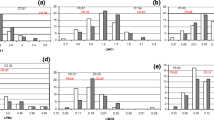Abstract
Many plants of tropical or subtropical origin, such as tomato, suffer damage under chilling temperatures (under 10°C but above 0°C). An earlier study identified several quantitative trait loci (QTLs) for shoot turgor maintenance (stm) under root chilling in an interspecific backcross population derived from crossing chilling-susceptible cultivated tomato (Lycopersicon esculentum) and chilling-tolerant wild L. hirsutum. The QTL with the greatest phenotypic effect on stm was located in a 28 cM region on chromosome 9 (designated stm9), and enhanced chilling-tolerance was conferred by the presence of the Lycopersicon hirsutum allele at this QTL. Here, near-isogenic lines (NILs) were used to verify the effect of stm9, and recombinant sub-NILs were used to fine map its position. Replicated experiments were performed with NILs and sub-NILs in a refrigerated hydroponic tank in the greenhouse. Sub-NIL data was analyzed using least square means separations, marker-genotype mean t-tests, and composite interval mapping. A dominant QTL controlling shoot turgor maintenance under root chilling was confirmed on chromosome 9 using both NILs and sub-NILs. Furthermore, sub-NILs permitted localization of stm9 to a 2.7 cM interval within the original 28 cM QTL region. If the presence of the L. hirsutum allele at stm9 also confers chilling-tolerance in L. esculentum plants grown under field conditions, it has the potential to expand the geographic areas in which cultivated tomato can be grown for commercial production.


Similar content being viewed by others
References
Alpert KB, Tanksley SD (1996) High-resolution mapping and isolation of a yeast artificial chromosome contig containing fw2.2—a major fruit weight quantitative trait locus in tomato. Proc Natl Acad Sci USA 93:15503–15507
Aroca R, Tognoni F, Irigoyen JJ, Sanches-Diaz M, Pardossi A (2001) Different root low temperature response to two maize genotypes differing in chilling sensitivity. Plant Physiol Biochem 39:1067–1073
Bagnall D, Wolfe J, King RW (1983) Chill-induced wilting and hydraulic recovery in mung bean plants. Plant Cell Environ 6:457–464
Basten CJ, Weir BS, Zeng ZB (1999) QTL cartographer. Version 1.13. North Carolina State University, Raleigh, NC
Bernacchi D, Beck-Bunn T, Emmatty D, Eshed Y, Inai S, Lopez J, Petiard V, Sayama H, Uhlig J, Zamir D, Tanksley S (1998) Advanced backcross QTL analysis of tomato. II. Evaluation of near-isogenic lines carrying single-donor introgressions for desirable yield QTL-alleles derived from Lycopersicon hirsutum and L. pimpinellifolium. Theor Appl Genet 97:1191–1196
Bloom AJ, Zwieniecki MA, Passioura JB, Randall LB, Holbrook NM, St. Clair DA (2004) Water relations under root chilling in a sensitive and tolerant tomato species. Plant Cell Environ 27:971–979
Brouwer DJ, St.Clair DA (2004) Fine mapping of three quantitative trait loci for late blight resistance in tomato using near isogenic lines (NILs) and sub-NILs. Theor Appl Genet 108:628–638
Brüggemann W, Klaucke S, Linger P, Lindhout P (1994) Quantitative physiological screening parameters for chilling tolerance in tomato breeding. Plant Physiol 105:14
Epstein E, Bloom AJ (2005) Mineral nutrition of plants: principles and perspectives, 2nd edn. Sinauer Associates, Sunderland
Eshed Y, Zamir D (1995) An introgression line population of Lycopersicon pennellii in the cultivated tomato enables the identification and fine mapping of yield-associated QTL. Genetics 141:1147–1162
Fennel A and Markhart AH (1998) Rapid acclimation of root hydraulic conductivity to low temperature. J Exp Bot 49:879–884
Foolad MR, Lin GY (2001) Genetic analysis of cold tolerance during vegetative growth in tomato, Lycopersicon esculentum Mill. Euphytica 122:105–111
Fridman E, Liu YS, Carmel-Goren L, Gur A, Shoresh M, Pleban T, Eshed Y, Zamir D (2002) Two tightly linked QTLs modify tomato sugar content via different physiological pathways. Mol Genet Genomics 266:821–826
Geisenberg C and Stewart K (1986) Field crop management. In: Atherton JG, Rudich J (eds) The tomato crop: a scientific basis for improvement. Chapman and Hall, London, pp 511–557
Guy CL (1994) Low temperature and crop yield. In: Boote KJ, Bennet JM, Sinclair TR, Paulsen GM (eds) Physiology and determination of crop yield. SSSA, ASA, CSSA, Madison, pp 417–424
Kamps TL, Isleib TG, Herner RC, Sink KC (1987) Evaluation of techniques to measure chilling injury in tomato. HortSci 22:1309–1312
Konieczny A, Ausubel FM (1993) A procedure for mapping Arabidopsis mutations using co-dominant ecotype-specific PCR-based markers. Plant J 4:403–410
Levene H (1960) Robust tests for equality of variances. In: Olkin I (ed) Contributions to probability and statistics: essays in honor of Harold Hotelling. Stanford University Press, Stanford, pp 278–292
Lincoln S, Daly M, Lander ES (1992) Constructing genetic maps with MAPMAKER/EXP 3.0, 3rd edn. The Whitehead Institute Technical Report
Liu J, van Eck J, Cong B, Tanksley SD (2002) A new class of regulatory genes underlying the cause of pear-shaped tomato fruit. Proc Natl Acad Sci USA 99:13302–13306
Lyons JM and Raison JK (1970) Oxidative activity of mitochondria isolated from plant tissues sensitive and resistant to chilling injury. Plant Physiol 45:386–389
Markhart AH, Piscus EL, Naylor AW, Kramer PJ (1979) Effect of temperature on water and ion transport in soybean and broccoli systems. Plant Physiol 64:83–87
Park YH, West MAL, St.Clair DA (2004) Evaluation of AFLPs for germplasm fingerprinting and assessment of genetic diversity in cultivars of tomato (Lycopersicon esculentum L.). Genome 47:510–518
Paterson AH, DeVerna JW, Lanini B, Tanksley SD (1990) Fine mapping of quantitative trait loci using selected overlapping recombinant chromosomes in an interspecific cross of tomato. Genetics 124:735–742
Rick CM (1983) Genetic variability in tomato species. Plant Mol Biol Rep 1:81–87
SAS Institute (1999) The SAS System for Windows. SAS OnlineDoc, version 8. SAS Institute, Cary, North Carolina, USA
Scott SJ, Jones RA (1986) Cold tolerance in tomato. II. Early seedling growth of Lycopersicon spp. Physiol Plant 66:659–663
Shapiro SS and Wilk MB (1965) An analysis of variance test for normality (complete samples). Biometrika 52:591–611
Spooner DM, Peralta IE, Knapp S (2005) Comparison of AFLPs with other markers for phylogenetic inference in wild tomatoes [ Solanum L. section Lycopersicon (Mill.) Wettst.] Taxon 54:43–61
Tanksley SD, Ganal MW, Prince JP, de Vicente MC, Bonierbale MW, Broun P, Fulton TM, Giovannoni JJ, Grandillo S, Martin GB, Messeguer R, Miller JC, Miller L, Paterson AH, Pineda O, Roder MS, Wing RA, Wu W, Young ND (1992) High density molecular linkage maps of the tomato and potato genomes. Genetics 132:1141–1160
Truco MJ, Randall LB, Bloom AJ, St.Clair DA (2000) Detection of QTLs associated with shoot wilting and root ammonium uptake under chilling temperatures in an interspecific backcross population from Lycopersicon esculentum × L. hirsutum. Theor Appl Genet 101:1082–1092
Tukey JW (1949) One degree of freedom for non-additivity. Biometrics 5:232–242
Vallejos CE (1979) Genetic diversity of plants for response to low temperatures and its potential use in crop plants. In: Lyons JM, Graham D, Raison JK (eds) Low temperature stress in crop plants. Academic, New York, pp 247–489
Vallejos CE, Tanksley SD (1983) Segregation of isozyme markers and cold tolerance in an interespecific backcross of tomato (Lycopersicon esculentum × Lycopersicon hirsutum). Theor Appl Genet 66:241–247
Walker MA, Smith DM, Pauls KP, McKersie BD (1990) A chlorophyll fluorescence screening test to evaluate chilling tolerance in tomato. HortSci 25:334–339
Wilson JM (1976) Mechanism of chill-hardening and drought-hardening of Phaseolus vulgaris leaves. New Phytol 76:257–270
Wolf S, Yakir D, Stevens MA, Rudich J (1986) Cold temperature tolerance of wild tomato species. J Am Soc Hort Sci 111:960–964
Yano M, Katayose Y, Ashikari M, Yamanouchi U, Monna L, Fuse T, Baba T, Yamamoto K, Umehara Y, Nagamura Y, Sasaki T (2000) Hd1, a major photoperiod sensitivity quantitative trait locus in rice, is closely related to the Arabidopsis flowering time gene CONSTANS. Plant Cell 12:2473–2483
Zeng Z-B (1994) Precision mapping of quantitative trait loci. Genetics 136:1457–1468
Acknowledgements
This research was supported in part by a United States Department of Agriculture National Research Initiative ‘Plant Responses to the Environment’ grant 00-35100-9530 to AJB and DAS.
Author information
Authors and Affiliations
Corresponding author
Additional information
Communicated by R. Hagemann
Rights and permissions
About this article
Cite this article
John Goodstal, F., Kohler, G.R., Randall, L.B. et al. A major QTL introgressed from wild Lycopersicon hirsutum confers chilling tolerance to cultivated tomato (Lycopersicon esculentum). Theor Appl Genet 111, 898–905 (2005). https://doi.org/10.1007/s00122-005-0015-2
Received:
Accepted:
Published:
Issue Date:
DOI: https://doi.org/10.1007/s00122-005-0015-2




